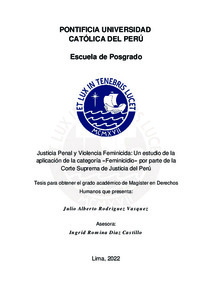Justicia penal y violencia feminicida: Un estudio de la aplicación de la categoría «feminicidio» por parte de la Corte Suprema de Justicia del Perú
Abstract
El feminicidio es una categoría empleada por los movimientos
feministas y, posteriormente, por los órganos internacionales de derechos
humanos para referirse a los homicidios de mujeres que constituyen violencia
basada en género. Esta categoría permite evidenciar la relación que existe
entre la muerte de una mujer en específico y un sistema social que subordina a
las mujeres como colectivo. En este contexto, la justicia penal es la
responsable de precisar qué casos concretos constituyen un feminicidio y, a
partir de ello, re-afirmar el derecho a las mujeres a vivir una vida libre de
violencia y de patrones estereotipados de género. Sin embargo, la tipificación
penal de la categoría feminicidio en las legislaciones latinoamericanas -
particularmente en la peruana- ha sido un proceso caracterizado por diversas
críticas, resistencias y dificultades. Como correlato, los tribunales han tenido
serios problemas para aplicar la categoría. En este escenario, la presente
investigación sistematizará y valorará críticamente las reglas que ha empleado
la Corte Suprema de Justicia del Perú para definir qué es y qué no es un
feminicidio. Con ello se identificará aquellos problemas interpretativos que han
sido superados -al menos a nivel de Corte Suprema- y aquellos que, al
persistir, mantienen vigentes serias lagunas de impunidad. Femicide is a category used by feminist movements and, later, by
international human rights bodies to refer to the homicides of women that
constitute gender-based violence. This category makes it possible to
demonstrate the relationship between the death of a specific soman and a
social system that subordinates women as a group. In this context, criminal
justice is responsible for specifying which specific cases constitute femicide
and, based on this, reaffirming the right of women to live a life free of violence
and stereotyped gender patterns. However, the criminal prohibition of the
femicide in Latin American legislation -particularly in Peru- has been a process
characterized by various criticisms, resistance, and difficulties. As a correlate,
this courts have had serious problems applying the category. In this scenario,
the present investigation will systematize and critically assess the rules that the
Suprema Court of Justice of Peru has used to define what is and what is not a
femicide. This will identify those interpretative problems that have been
overcome -at least at the Suprema Court level- and those that, by persisting,
maintain serious impunity gaps.
Temas
Perú. Corte Suprema de Justicia
Mujeres--Violencia contra--Perú
Administración de justicia penal--Perú
Mujeres--Violencia contra--Perú
Administración de justicia penal--Perú
Para optar el título de
Magíster en Derechos Humanos





